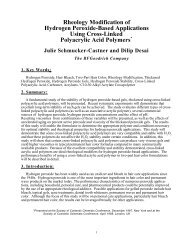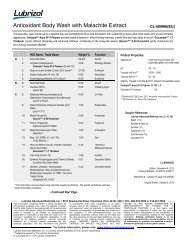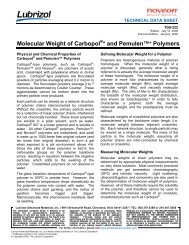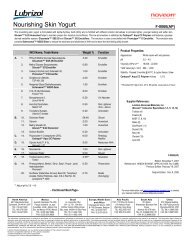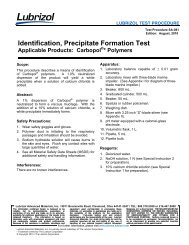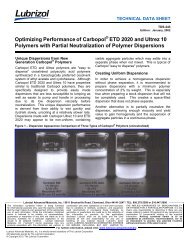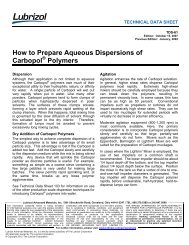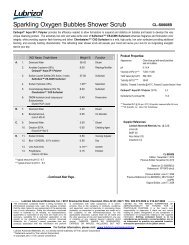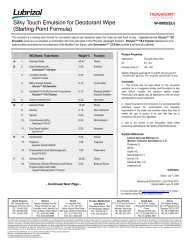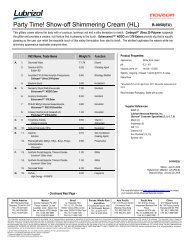Flow and Suspension Properties of Carbopol Polymers ... - Lubrizol
Flow and Suspension Properties of Carbopol Polymers ... - Lubrizol
Flow and Suspension Properties of Carbopol Polymers ... - Lubrizol
You also want an ePaper? Increase the reach of your titles
YUMPU automatically turns print PDFs into web optimized ePapers that Google loves.
<strong>Flow</strong> <strong>and</strong> <strong>Suspension</strong> <strong>Properties</strong> <strong>of</strong><br />
<strong>Carbopol</strong> ® <strong>Polymers</strong><br />
Basic Concepts <strong>of</strong> Rheology<br />
Rheology is the study <strong>of</strong> the deformation <strong>and</strong> flow <strong>of</strong> a<br />
material when it is subjected to an applied force. When<br />
force is applied to a material, the material may respond<br />
in a number <strong>of</strong> ways. One response is for the material<br />
to relieve the strain by flowing. In such cases the<br />
material is said to be a liquid. A material will always<br />
resist an imposed force to some degree. Otherwise, it<br />
would have no original form at all. The measure <strong>of</strong> a<br />
flowing liquid to resist an applied shearing force is<br />
called its internal friction or viscosity.<br />
Figure 1 illustrates some basic flow concepts. Imagine<br />
two parallel plates separated by a distance X. The<br />
space between the plates is filled with a fluid. A<br />
sufficient, constant force is applied to the top plate<br />
(which has a given area) so that this plan moves at a<br />
fixed velocity. The force applied to this system may be<br />
thought <strong>of</strong> in terms <strong>of</strong> shear stress.<br />
Shear Stress = Force/Area<br />
Shear stress is measured in dynes/cm2. (A dyne is the<br />
force needed to accelerate one gram <strong>of</strong> mass by one<br />
cm/sec/sec.)<br />
Liquid next to the top plate flows at the top plate<br />
velocity, while liquid next to the stationary bottom plate<br />
flows at zero velocity. A velocity gradient exists from<br />
top to bottom with intermediate velocities between the<br />
plates. This velocity gradient is the response <strong>of</strong> the<br />
system <strong>and</strong> is called the rate <strong>of</strong> deformation or shear<br />
rate (measured in reciprocal seconds, sec-l):<br />
Shear Rate = Velocity/X<br />
TECHNICAL DATA SHEET<br />
TDS-180<br />
Edition: January, 2002<br />
The ratio <strong>of</strong> shear stress to shear rate is the coefficient<br />
<strong>of</strong> viscosity, more commonly referred to simply as<br />
viscosity<br />
Viscosity = Shear Stress/Shear Rate<br />
The unit <strong>of</strong> viscosity measurement is the poise (1 dynesec/cm2)<br />
or centipoise (100 cP = 1 poise). Viscosity<br />
may be thought <strong>of</strong> as a measurement <strong>of</strong> the force per<br />
unit area required to maintain a certain rate <strong>of</strong> flow. All<br />
flowing materials exhibit viscosity. Some typical values<br />
are shown here:<br />
Material Viscosity, cP<br />
Air 0.01<br />
Water 1<br />
Oils 100-100,000<br />
<strong>Lubrizol</strong> Advanced Materials, Inc. / 9911 Brecksville Road, Clevel<strong>and</strong>, Ohio 44141-3247 / TEL: 800.379.5389 or 216.447.5000<br />
The information contained herein is being furnished combination with other substances or in the User’s process. THE IMPLIED WARRANTIES OF MERCHANTABILITY<br />
for informational purposes only, upon the express condition Due to variations in methods, conditions <strong>and</strong> equipment OR FITNESS FOR A PARTICULAR PURPOSE. It is the<br />
that the User makes its own assessment <strong>of</strong> the appropriate used commercially in processing these materials, no User’s sole responsibility to determine if there are any<br />
use <strong>of</strong> such information. While the information contained warranties or guarantees are made as to the suitability <strong>of</strong> issues relating to patent infringement <strong>of</strong> any component or<br />
herein is believed to be reliable, no representations, the information or products for the applications combination <strong>of</strong> components relating to the supplied<br />
guarantees or warranties <strong>of</strong> any kind are made as to its disclosed. <strong>Lubrizol</strong> shall not be liable <strong>and</strong> the User information. Nothing contained herein is to be<br />
accuracy, suitability for a particular application or the assumes all risk <strong>and</strong> responsibility for any use or considered as permission, recommendation, nor as<br />
results to be obtained herefrom. <strong>Lubrizol</strong> Advanced h<strong>and</strong>ling <strong>of</strong> any material beyond <strong>Lubrizol</strong>'s direct an inducement to practice any patented invention<br />
Materials, Inc. ("<strong>Lubrizol</strong>") cannot guarantee how any control. LUBRIZOL MAKES NO WARRANTIES, EXPRESS without permission <strong>of</strong> the patent owner.<br />
products associated with this information will perform in OR IMPLIED, INCLUDING, BUT NOT LIMITED TO,<br />
For further information, please visit: www.lubrizol.com/personalcare<br />
<strong>Lubrizol</strong> Advanced Materials, Inc. is a wholly owned subsidiary <strong>of</strong> The <strong>Lubrizol</strong> Corporation<br />
All trademarks owned by The <strong>Lubrizol</strong> Corporation<br />
© Copyright 2012 / The <strong>Lubrizol</strong> Corporation
Types <strong>of</strong> <strong>Flow</strong> Behavior<br />
There are many types <strong>of</strong> flow behavior which are<br />
broadly categorized as either Newtonian or non-<br />
Newtonian. In Newtonian flow, the shear stress <strong>and</strong><br />
shear rate are always in direct proportion to each other.<br />
The viscosity <strong>of</strong> a Newtonian fluid will always be the<br />
same, regardless <strong>of</strong> the shear stress or shear rate.<br />
Newtonian flow behavior is shown in Figure 2; the line<br />
will always be straight <strong>and</strong> will intercept the origin.<br />
Examples <strong>of</strong> Newtonian liquids are water, light oils <strong>and</strong><br />
other systems in which any dissolved material is low in<br />
molecular weight, is non-associating, <strong>and</strong> has limited<br />
interaction with the solvent<br />
In more complex systems, however, the response to<br />
applied stress is non-linear. These non-Newtonian<br />
systems are characterized by large dissolved or<br />
solvated molecules, with a tendency to reassociate <strong>and</strong><br />
a strong interaction with the solvent. In Figure 2, four<br />
types <strong>of</strong> non-Newtonian flow are shown.<br />
Dilatant - Occurs in suspensions that contain high<br />
concentrations <strong>of</strong> closely-packed solids. Examples:<br />
concrete, toothpaste, cake icings.<br />
Pseudoplastic - When viscosity decreases with<br />
increasing shear rates, flow characteristics are said to<br />
be pseudoplastic. Often referred to as "shear thinning,"<br />
this flow is encountered with large swollen or dissolved<br />
particles, such as emulsions <strong>and</strong> polymer solutions.<br />
Examples: solutions <strong>of</strong> guar gum, cellulosic thickeners,<br />
alginates.<br />
Bingham Plastic - Requires the application <strong>of</strong> a<br />
minimum amount <strong>of</strong> shear stress before flow begins.<br />
Examples: catsup, PVC <strong>and</strong> styrene polymers.<br />
Ellis Plastic - Similar to pseudoplastic flow except that a<br />
minimum amount <strong>of</strong> shear stress is needed to initiate<br />
flow. Example: <strong>Carbopol</strong> polyacrylic acid thickeners in<br />
water.<br />
TDS-180<br />
<strong>Flow</strong> <strong>and</strong> <strong>Suspension</strong> <strong>Properties</strong> <strong>of</strong> <strong>Carbopol</strong> ® <strong>Polymers</strong><br />
Page 2 <strong>of</strong> 11<br />
<strong>Flow</strong> Characteristics <strong>of</strong> <strong>Carbopol</strong> Systems<br />
<strong>Carbopol</strong> polymers can be used to provide a wide range<br />
<strong>of</strong> flow properties. High molecular weight, highly<br />
crosslinked polymers such as <strong>Carbopol</strong> 940 <strong>and</strong> 934<br />
provide mucilages with a very short flow rheology.<br />
Short flow can be characterized as a gelled consistency<br />
similar to mayonnaise. In contrast, <strong>Carbopol</strong> 941, a<br />
lower molecular weight, more highly crosslinked<br />
polymer, provides a fairly long flow rheology. Materials<br />
with long flow rheology are "stringy" <strong>and</strong> flow like honey.<br />
In Figure 3, the shear thinning nature <strong>of</strong> several<br />
<strong>Carbopol</strong> polymers is shown. The shear rate is varied<br />
by changing the spindle RPM on a Brookfield<br />
viscometer. While the viscosity is very high at low<br />
RPM, it rapidly drops at higher shear rates. This is a<br />
desirable property, for instance, when sag resistance is<br />
required (high viscosity at low shear rate), but easy<br />
spraying, brushing or troweling is needed (low viscosity<br />
at high shear rate).
Thixotropy<br />
Thixotropy is defined as, ". . . a decrease in viscosity<br />
under stress, followed by gradual recovery when the<br />
stress is removed. The effect is time dependent"1<br />
A thixotropic system is one in which (1) shear thinning<br />
occurs as stress is increased; <strong>and</strong> (2) the flow curve is<br />
less non-Newtonian when the stress is rapidly removed.<br />
A thixotropic material is characterized by the hysteresis<br />
loop shown in Figure 4. It occurs, for instance when a<br />
dispersed polymer has structure which is broken by the<br />
shearing force. Upon st<strong>and</strong>ing (no shear stress) the<br />
structure reforms with time.<br />
Most <strong>Carbopol</strong> polymer gels exhibit little or no<br />
thixotropy. Highly viscous media can be spread, stirred<br />
or pumped, but when the stress ceases, recovery to the<br />
original viscosity is instantaneous.<br />
TDS-180<br />
<strong>Flow</strong> <strong>and</strong> <strong>Suspension</strong> <strong>Properties</strong> <strong>of</strong> <strong>Carbopol</strong> ® <strong>Polymers</strong><br />
Page 3 <strong>of</strong> 11<br />
Macroviscosity vs. Microviscosity<br />
When a Brookfield viscometer or similar bulk method is<br />
used to study a gel, it is the macroviscosity <strong>of</strong> the<br />
material that is determined. While this provides useful<br />
information for most purposes, it fails to give an<br />
underst<strong>and</strong>ing <strong>of</strong> the nature <strong>of</strong> the microstructure <strong>of</strong> the<br />
gel.<br />
In the specific case <strong>of</strong> <strong>Carbopol</strong> crosslinked polyacrylic<br />
acid based gels, there exist interstitial spaces between<br />
the swollen <strong>Carbopol</strong> gel particles. The liquid in these<br />
interstitial spaces has its own viscosity, called<br />
microviscosity.<br />
The viscosity was measured experimentally by ~R.Y.<br />
Lochhead et al2 using gold sols with a particle size <strong>of</strong><br />
0.1 microns.<br />
In Figure 5, it can be seen that the microviscosity <strong>and</strong><br />
macroviscosity for a highly crosslinked <strong>Carbopol</strong><br />
polymer differ dramatically. In fact, the microviscosity <strong>of</strong><br />
the interstitial fluid at low <strong>Carbopol</strong> polymer<br />
concentrations is nearly that <strong>of</strong> pure water. The amount<br />
<strong>of</strong> interstitial fluid <strong>and</strong> its microviscosity play an<br />
important role in the yield value provided by different<br />
<strong>Carbopol</strong> polymer grades.
Yield Value<br />
Yield value is commonly defined as initial resistance to<br />
flow shear applied stress. In the case <strong>of</strong> Bingham <strong>and</strong><br />
Ellis plastic flow, a minimum shear stress is required to<br />
initiate flow. This minimum stress is known as the yield<br />
value or yield index. A practical application <strong>of</strong> yield<br />
value is the suspension <strong>of</strong> particles in a liquid. Unless<br />
the force <strong>of</strong> gravity operating on a suspended particle <strong>of</strong><br />
a given mass exceeds the liquid's yield value, it will not<br />
descend.<br />
If a product has both yield value <strong>and</strong> shear thinning<br />
properties - as <strong>Carbopol</strong> polymer based products do - it<br />
will appear to be very viscous, but will move easily<br />
when force is applied to it.<br />
Yield value is a critical property for a number <strong>of</strong><br />
applications:<br />
<strong>Suspension</strong>s -The words "shake well before using" on a<br />
label are a sure indication that the product has<br />
insufficient yield value. Any particles dispersed in a<br />
liquid will be permanently suspended if the liquid's yield<br />
value is sufficient to overcome the effect <strong>of</strong> gravity on<br />
those particles.<br />
TDS-180<br />
<strong>Flow</strong> <strong>and</strong> <strong>Suspension</strong> <strong>Properties</strong> <strong>of</strong> <strong>Carbopol</strong> ® <strong>Polymers</strong><br />
Page 4 <strong>of</strong> 11<br />
Vertical Coatings - With sufficient yield value, a gelled<br />
coating, such as a paint stripper, will not sag down a<br />
vertical surface.<br />
Emulsions - In the same way that yield value prevents a<br />
suspended particle from settling, it can also prevent an<br />
oil droplet from rising <strong>and</strong> coalescing.<br />
Foam - Foam is essentially the suspension <strong>of</strong> gaseous<br />
"particles in a medium. If that medium is a liquid during<br />
processing or in its final form, a minimum yield value is<br />
needed for a uniform distribution <strong>of</strong> the gas.<br />
<strong>Carbopol</strong> polymers are very effective in forming plastic<br />
flow solutions with significant yield value. This can<br />
easily be seen in neutralized gels <strong>of</strong> <strong>Carbopol</strong> polymers<br />
which are stiff, strong gels at rest, but flow easily when<br />
enough force is applied. This enables viscous gels <strong>of</strong><br />
<strong>Carbopol</strong> polymers to be stirred, pumped <strong>and</strong> spread<br />
easily.
Measurement <strong>of</strong> Yield Value<br />
There are several ways to measure the flow properties<br />
<strong>of</strong> systems which contain <strong>Carbopol</strong> polymers including<br />
Brookfield viscometer extrapolation, the suspended<br />
sphere test method, the B.P. plastometer <strong>and</strong> the<br />
constant stress rheometer (not discussed here).<br />
Brookfield Viscometer Method - The Brookfield RVT<br />
Viscometer is convenient for measurement at low shear<br />
rates. It measures the torque required to rotate a<br />
spindle through a sample at 0.05 to 100 rpm.<br />
Multiplying the torque dial reading by a constant<br />
(depending on the spindle size <strong>and</strong> speed) gives the<br />
apparent viscosity. Increasing the speed results in a<br />
corresponding increase in shear rate. In this way, flow<br />
properties can be examined by observing torque as<br />
spindle speed is varied. Data in Figure 6 represent<br />
typical flow curves <strong>of</strong> water-soluble polymers obtained<br />
with a Brookfield Viscometer.<br />
Figure 7 shows that <strong>Carbopol</strong> 941 polymer is more<br />
efficient in generating high yield values at low<br />
viscosities than the other <strong>Carbopol</strong> polymers.<br />
TDS-180<br />
<strong>Flow</strong> <strong>and</strong> <strong>Suspension</strong> <strong>Properties</strong> <strong>of</strong> <strong>Carbopol</strong> ® <strong>Polymers</strong><br />
Page 5 <strong>of</strong> 11<br />
Because yield value is a zero-shear-rate property, it can<br />
be approximated with a Brookfield RVT Viscometer <strong>and</strong><br />
this equation:<br />
Brookfield Yield Value =<br />
(Apparent Viscosity at 0.5 rpm -<br />
Apparent Viscosity at 1 rpm)<br />
100<br />
The equation given above shows that a polymer<br />
solution can be characterized by yield value as well as<br />
viscosity, which is important in permanence <strong>of</strong><br />
emulsions <strong>and</strong> suspensions.
The minimum Brookfield Yield Value which is required<br />
to permanently suspend a particle can be calculated<br />
from the following equation:<br />
Brookfield Yield Value = [23.6 R (D – D0)g]2/3<br />
where:<br />
R is the particle radius in cm<br />
D is the particle density in gm/cc<br />
D0 is the density <strong>of</strong> the medium in gm/cc<br />
g is the acceleration due to gravity in cm/cc<br />
Suspended Sphere Method - The recently-developed<br />
suspended sphere method is direct <strong>and</strong> underst<strong>and</strong>able,<br />
albeit time-consuming <strong>and</strong> impractical for<br />
routine evaluations. Up to 30 spheres <strong>of</strong> varying<br />
density <strong>and</strong> size are suspended in a gel to determine its<br />
yield value. As shown in Figure 8, a specific minimum<br />
yield value is required to suspend each <strong>of</strong> these<br />
spheres in a water-based gel. The minimum value is<br />
dependent on the sphere's density <strong>and</strong> size.<br />
The location <strong>of</strong> each sphere in the gel is marked in the<br />
container wall <strong>and</strong> the gel is stored for one month at<br />
room temperature. If no appreciable sphere movement<br />
is noted, it is considered suspended. The yield value <strong>of</strong><br />
a particular gel is that associated with the largest, most<br />
dense sphere that did not begin settling (from Figure 8).<br />
The true gel yield value may be slightly higher (between<br />
the suspended sphere <strong>and</strong> the next larger sphere which<br />
began to settle).<br />
This suspended sphere test was performed at ten<br />
concentrations <strong>of</strong> the following suspending aids in<br />
water.<br />
TDS-180<br />
<strong>Flow</strong> <strong>and</strong> <strong>Suspension</strong> <strong>Properties</strong> <strong>of</strong> <strong>Carbopol</strong> ® <strong>Polymers</strong><br />
Page 6 <strong>of</strong> 11
Chemical Name Trade Name Supplier<br />
Polyacrylic Acid <strong>Carbopol</strong> 940 <strong>Lubrizol</strong><br />
Polyacrylic Acid <strong>Carbopol</strong> 934 <strong>Lubrizol</strong><br />
Polyacrylic Acid <strong>Carbopol</strong> 941 <strong>Lubrizol</strong><br />
Carageenan carageenan 231 FMC Corp.<br />
Carboxymethyl Cellulose CMC-7H Aqualon<br />
Xanthan Gum Kelzan S Kelco<br />
Algin Kelgin HV Kelco<br />
Magnesium Aluminum Silicate Veegum T R.T. V<strong>and</strong>erbilt<br />
Acrylic Emulsion Acrysol ASE-60 Rohm & Haas<br />
Tragacanth Gum Tragacanth Gum Rhone-Poulenc<br />
Locust Bean Gum Locust Bean 175 Rhone-Poulenc<br />
Guar Gum Galactasol 416 Aqualon<br />
Hydroxyethyl Cellulose Natrosol Plus 430 Aqualon<br />
Hydroxypropyl Methylcellulose Methocel J12MS Dow Chemical<br />
Polyethylene Oxide Polyox WSR-301 Union Carbide<br />
Fumed Silica Cab-O-Sil M-5 Cabot Corp.<br />
The results <strong>of</strong> a performance <strong>of</strong> the suspended sphere<br />
test on the above suspending aids is shown in Figure 9.<br />
An attempt was made to select the most effective grade<br />
<strong>of</strong> suspending aid in each group, <strong>and</strong> to use it in the<br />
manner prescribed by the manufacturer. However,<br />
certain techniques <strong>and</strong> product grades may have been<br />
overlooked which would have improved the suspending<br />
results <strong>of</strong> one or more suspending aids.<br />
TDS-180<br />
<strong>Flow</strong> <strong>and</strong> <strong>Suspension</strong> <strong>Properties</strong> <strong>of</strong> <strong>Carbopol</strong> ® <strong>Polymers</strong><br />
Page 7 <strong>of</strong> 11<br />
In most <strong>of</strong> the range examined, a <strong>Carbopol</strong> polymer was<br />
ten-to-fifty times more efficient in delivering yield value<br />
than other suspending aids. If extremely high yield<br />
values are required, <strong>Carbopol</strong> 934 is a good choice.<br />
For most other yield value requirements, <strong>Carbopol</strong> 940<br />
is recommended. Although concentra-tions below 0.1%<br />
were not examined here, <strong>Carbopol</strong> 941 may be the best<br />
choice if very low yield values are needed. (See "Effect<br />
<strong>of</strong> Crosslink Density on Suspending Ability" section<br />
below.) The crosslink density <strong>of</strong> <strong>Carbopol</strong> polymers<br />
affects their suspending ability at various<br />
concentrations.<br />
B.P. Yield Value Determination - The B.P. (British<br />
Pharmacopoeia) plastometer value test is based upon<br />
the earlier work <strong>of</strong> Voet <strong>and</strong> Br<strong>and</strong> who used a parallel<br />
plate rheometer to evaluate the flow properties <strong>of</strong><br />
printing inks. The method allows for a direct<br />
determination <strong>of</strong> yield value, rather than an<br />
approximation.<br />
The apparatus consists <strong>of</strong> two clear soda-glass plates,<br />
100 mm x 100mm x 3mm. The plates are marked with<br />
a diamond marker to show center <strong>and</strong> corner alignment<br />
<strong>and</strong> four sample location points equidistant from the<br />
plate center <strong>and</strong> the four corners. (See Figure 10.) The<br />
test is conducted at room temperature.<br />
Four drops <strong>of</strong> sample gel (applied to each <strong>of</strong> the four<br />
corner points) are s<strong>and</strong>wiched between the glass plates<br />
<strong>and</strong> the drops are allowed to spread out until equilibrium<br />
is reached. The final diameters <strong>of</strong> the drops are<br />
measured <strong>and</strong> the yield value is calculated as follows:
B.P. Yield Value =<br />
1192<br />
d 5<br />
NM -2<br />
where d = average final zone diameter (cm)<br />
Effect <strong>of</strong> Crosslink Density on Suspending<br />
Ability<br />
<strong>Carbopol</strong> 941 is a lightly crosslinked polymer.<br />
Because there are few crosslink sites to constrain the<br />
polymer, it "opens up" easily at low concentrations.<br />
Consequently, the interstitial spaces between the<br />
swollen gel particles are eliminated at low<br />
concentration <strong>and</strong> the microviscosity roughly equals<br />
the macroviscosity. Due to the limited crosslinking,<br />
however, the polymer lacks rigidity. Even at higher<br />
concentrations, it provides little additional yield value.<br />
(See Figure 11.)<br />
<strong>Carbopol</strong> 934 is a heavily crosslinked polymer.<br />
Because there are many crosslink sites to constrain<br />
the polymer, it does not "open up" easily at low<br />
concentrations. For this reason, there are large<br />
interstitial spaces between the swollen gel particles<br />
which have very low microviscosity <strong>and</strong> cannot<br />
suspend insoluble particles well. At high<br />
concentrations, however, these rigid gel particles<br />
begin to touch producing a system with very high<br />
yield value. (See Figure 11.)<br />
TDS-180<br />
<strong>Flow</strong> <strong>and</strong> <strong>Suspension</strong> <strong>Properties</strong> <strong>of</strong> <strong>Carbopol</strong> ® <strong>Polymers</strong><br />
Page 8 <strong>of</strong> 11
Yield Value Is Not Viscosity Dependent<br />
The importance <strong>of</strong> yield value can be seen in Table<br />
1. Several mm average diameter silica s<strong>and</strong> particles<br />
were placed in gels based on various thickener types<br />
<strong>and</strong> concentrations. These data dispel the common<br />
misconception that high viscosity is needed to create<br />
a stable suspension. Viscosity can only slow down<br />
the rate <strong>of</strong> settling, but yield value is needed to<br />
create permanent suspensions. The critical<br />
minimum required Brookfield yield value range is<br />
between 90 <strong>and</strong> 124.<br />
Another simple demonstration will further illustrate<br />
the distinction between viscosity <strong>and</strong> yield value. In<br />
Figure 12, four water-based gels are shown:<br />
A. 2.1 % Guar gum<br />
B. 2.3% Carboxymethyl cellulose<br />
C. 6.0% Xanthan gum<br />
D. 0.4% <strong>Carbopol</strong> 940 polymer<br />
These concentrations were chosen because they all<br />
produce the same approximate viscosity: 33,000 cP<br />
(Brookfield, 20 rpm, 20°C). Into each <strong>of</strong> these gels<br />
were placed four spheres <strong>of</strong> varying density <strong>and</strong> size.<br />
The low-density plastic spheres on the left are easier<br />
to suspend than the high-density steel spheres on<br />
the right Figure 12 shows how well each gel<br />
suspended these spheres after one month <strong>of</strong><br />
storage. A ring on each marks the initial position <strong>of</strong><br />
each sphere.<br />
TDS-180<br />
<strong>Flow</strong> <strong>and</strong> <strong>Suspension</strong> <strong>Properties</strong> <strong>of</strong> <strong>Carbopol</strong> ® <strong>Polymers</strong><br />
Page 9 <strong>of</strong> 11<br />
The guar gum <strong>and</strong> CMC-based gels <strong>of</strong>fered little or<br />
no initial resistance to the force <strong>of</strong> gravity - no<br />
appreciable yield value. Even though their viscosity<br />
was the same, the xanthan gum <strong>and</strong> <strong>Carbopol</strong><br />
polymer based gels delivered much more yield value<br />
or suspending ability. Imagine a pebble dropped into<br />
jars <strong>of</strong> honey <strong>and</strong> mayonnaise: even though the<br />
honey may have high viscosity, it can only slow the<br />
rate <strong>of</strong> settling. It lacks the yield value <strong>of</strong> the<br />
mayonnaise. The yield value provided by <strong>Carbopol</strong><br />
polymers gives stability to emulsions <strong>and</strong><br />
suspensions. In these systems, the problem <strong>of</strong><br />
stability is one <strong>of</strong> preventing separation <strong>of</strong> phases<br />
(creaming, breaking <strong>of</strong> emulsions <strong>and</strong> settling <strong>of</strong><br />
solids in suspensions).<br />
Table 1<br />
EFFECT OF YIELD VALUE ON SAND SUSPENSION<br />
Brookfield Yield<br />
Material Brookfield V20 cP Value S<strong>and</strong> <strong>Suspension</strong><br />
0.15% <strong>Carbopol</strong> ® 941 polymer 2,190 500 Permanent<br />
0.15% <strong>Carbopol</strong> ® 934 polymer 6,350 410 Permanent<br />
3.0% Gum tragacanth (homogenized) 9,740 276 Permanent<br />
3.0% Gum tragacanth (aged two months) -- 144 Permanent<br />
0.18% <strong>Carbopol</strong> ® 934 polymer 2,420 136 Permanent<br />
0.10% <strong>Carbopol</strong> ® 941 polymer 1,950 124 Permanent<br />
0.15% <strong>Carbopol</strong> ® 934 polymer 1,600 90 48 hours<br />
2.5% Locust bean gum 22,800 80 8 hours<br />
1.5% Polyethylene oxide 2,040 40 3 hours<br />
1.5% Sodium carboxymethylcellulose 5,900 36 3 hours<br />
1.5% Guar gum 8,040 32 4 hours<br />
2.5% Sodium alginate 8,360 16 2 hours<br />
0% Gum tragacanth (low shear make-up) 940 5 2 hours<br />
2.0% Methyl cellulose 3,200 0 1.5 hours
Common methods <strong>of</strong> preventing phase separation<br />
include altering droplet or particle size, reducing the<br />
difference in density between the dispersed phase <strong>and</strong><br />
dispersion medium, increasing the viscosity <strong>of</strong> the<br />
dispersion medium, <strong>and</strong> agitation. <strong>Carbopol</strong> polymers<br />
give permanently stable emulsions <strong>and</strong> suspensions<br />
by building yield value in the dispersion medium, <strong>and</strong><br />
controlling the flow rate between the dispersed phase<br />
<strong>and</strong> the dispersion medium. Because yield value is<br />
nondirectional, the dispersion medium resists<br />
movement <strong>of</strong> particles or oil droplets. The relative<br />
shear sensitivity <strong>of</strong> the various <strong>Carbopol</strong> polymers is<br />
shown in Figure 13.<br />
Brookfield Viscosity Procedure<br />
Use this procedure to determine Brookfield viscosity <strong>of</strong><br />
mucilages <strong>of</strong> <strong>Carbopol</strong> polymers prepared with low<br />
shear agitation.<br />
Remember that minute amounts <strong>of</strong> most metallic ions<br />
interfere with the swelling activity <strong>of</strong> <strong>Carbopol</strong><br />
polymers. C.P. sodium hydroxide <strong>and</strong> distilled or<br />
demineralized water should be employed.<br />
TDS-180<br />
<strong>Flow</strong> <strong>and</strong> <strong>Suspension</strong> <strong>Properties</strong> <strong>of</strong> <strong>Carbopol</strong> ® <strong>Polymers</strong><br />
Page 10 <strong>of</strong> 11<br />
Apparatus<br />
1. Torsion or other balance capable <strong>of</strong> ± 0.002 gm.<br />
accuracy.<br />
2. Lightnin' Mixer, Model F, with 3-blade marine<br />
impeller.<br />
3. Electric timer, preferably with controlled electrical<br />
outlet, or stop watch.<br />
4. Lightnin' Mixer or other mixer capable <strong>of</strong> 300 rpm<br />
speed, with 4-inch 'S' stirrer.<br />
5. Constant temperature water bath.<br />
6. Brookfield Viscometer, Model RVF or RVT.<br />
7. 1000 ml Griffin beaker.<br />
8. 500 ml graduated cylinder.<br />
9. Tachometer or revolution counter.<br />
10. Rubber policeman.<br />
11. Centigrade thermometer.<br />
12. Aluminum weighing dish.<br />
13. pH meter.<br />
14. Automatic burette attached to h<strong>and</strong>iboy dispenser<br />
tube.<br />
15. Pyrex tannin dish 70 x 50 mm.<br />
Procedure<br />
1. Weigh out the <strong>Carbopol</strong> polymer to ± 0.005 gm<br />
onto the aluminum dish.<br />
0.25 gm for 0.05% solution<br />
1.00 gm for 0.2% solution<br />
2.50 gm for 0.5% solution<br />
5.00 gm for 1.0% solution<br />
2. Measure 500 ml demineralized water in the<br />
graduated cylinder <strong>and</strong> transfer the water to the<br />
1000 ml beaker.
3. Place the beaker under the stirrer with the shaft<br />
set at angle <strong>of</strong> 60°, <strong>of</strong>f to one side <strong>of</strong> the beaker,<br />
<strong>and</strong> with the propeller as near the beaker bottom<br />
as possible.<br />
4. Turn on the mixer <strong>and</strong> use the tachometer to<br />
adjust the mixer speed to approximately 1000<br />
rpm.<br />
5. Carefully add the <strong>Carbopol</strong> polymer to the water.<br />
Allow the dish to touch the vibrating stirrer shaft to<br />
slowly sift the <strong>Carbopol</strong> polymer into the beaker.<br />
Break up any loose agglomerates with the rubber<br />
policeman before adding to the water. Total<br />
addition time should be 3/4 to 1-1/2 minutes.<br />
CAUTION: Do not allow the polymer to form a<br />
continuous film on the surface <strong>of</strong> the water. If this<br />
is done, the polymer will clump <strong>and</strong> be<br />
inadequately dispersed by this mixing procedure.<br />
Gross errors in mucilage viscosity determination<br />
can result.<br />
6. After all the <strong>Carbopol</strong> polymer has been added,<br />
start the timer <strong>and</strong> continue stirring at 1000 rpm<br />
for 15 minutes. (A timed outlet on the timer is<br />
useful.) Scrape any polymer from the sides <strong>of</strong> the<br />
beaker <strong>and</strong> stirrer shaft with the rubber policeman<br />
during the dispersion.<br />
7. Remove the stirrer from the dispersion <strong>and</strong> place<br />
the beaker containing the dispersion in a water<br />
bath at 25 ± 0.2°C for 30 minutes. This assures<br />
complete polymer hydration <strong>and</strong> allows any foam<br />
to break. If any foam persists, it should be<br />
completely eliminated. A convenient method is to<br />
carefully direct an air stream at the surface <strong>of</strong> the<br />
dispersion.<br />
8. Adjust the paddle mixer speed to 300 ± 10 rpm.<br />
Turn it <strong>of</strong>f <strong>and</strong> place the beaker containing the<br />
polymer dispersion under the paddle Stirrer. Set<br />
the paddle at such a depth that air is not drawn<br />
into the dispersion. Turn on the mixer.<br />
9. Add 3 to 5 drops phenolphthalein solution <strong>and</strong> 10<br />
to l5 drops bromthymol blue solution.<br />
10. Rapidly add the l8% sodium hydroxide below the<br />
surface <strong>of</strong> the dispersion. Add:<br />
0.6 ml <strong>of</strong> 18% NaOH for 0.05% mucilage<br />
2.1 ml <strong>of</strong> 18% NaOH for 0.2% mucilage<br />
6.2 ml <strong>of</strong> 18% NaOH for 0.5% mucilage<br />
12.6 ml <strong>of</strong> 18% NaOH for 1.0% mucilage<br />
Stir 2 or 3 minutes until neutralization is complete.<br />
(This is determined colorimetrically. Any excess<br />
sodium hydroxide at the surface will give an<br />
intense red color. Complete neutralization has<br />
been effected when an even, light blue color is<br />
obtained.)<br />
TDS-180<br />
<strong>Flow</strong> <strong>and</strong> <strong>Suspension</strong> <strong>Properties</strong> <strong>of</strong> <strong>Carbopol</strong> ® <strong>Polymers</strong><br />
Page 11 <strong>of</strong> 11<br />
11. Check the pH with the pH meter to make sure it is<br />
between 7.3 <strong>and</strong> 7.8. If the pH is below 7.3, raise<br />
the pH with additional sodium hydroxide. If it is<br />
above 7.8, discard the sample <strong>and</strong> remake the<br />
mucilage.<br />
12. Return the neutralized mucilage to the 25°C water<br />
bath for 1 hour.<br />
NOTE: Run the determination in 60 to 75 minutes<br />
to avoid slight viscosity changes occurring after 75<br />
minutes<br />
13. After making certain the mucilage pH is 7.3 to 7.8<br />
<strong>and</strong> its temperature is between 24.5 <strong>and</strong> 25.5°C,<br />
measure the viscosity on the Brookfield RVF or<br />
RVT viscometer at 20 rpm. Use the spindle noted<br />
on the specification for the <strong>Carbopol</strong> polymer <strong>and</strong><br />
concentration being tested.<br />
Take a reading at 3, 6 <strong>and</strong> 9 revolutions <strong>and</strong><br />
record the average <strong>of</strong> these readings. The total<br />
range <strong>of</strong> the 3 readings must not exceed 0.5 scale<br />
units on the 100 unit scale.<br />
Calculations<br />
Viscosity, cP = Dial reading x Constant for speed<br />
<strong>and</strong> spindle used<br />
Special Instructions<br />
1. Preparation <strong>of</strong> 18% sodium hydroxide. Slowly add<br />
45 g <strong>of</strong> C.P. sodium hydroxide pellets to 205 ml <strong>of</strong><br />
boiled, demineralized or distilled water.<br />
CAUTION: Considerable heat will be generated as<br />
the sodium hydroxide dissolves, so the container<br />
should be cooled<br />
Store in an air-tight container to avoid sodium<br />
carbonate formation. Exercise extreme care to<br />
avoid contact with skin or eyes.<br />
2. Bromthymol blue indicator, 0.1%-0.1 g per 100 ml<br />
<strong>of</strong> 20% ethanol.<br />
3. Phenolphthalein indicator - 1.0 g dissolved in 60 ml<br />
ethanol <strong>and</strong> diluted to 100 ml with demineralized<br />
water.<br />
4. All dial readings in the viscometer should be<br />
greater than 10 <strong>and</strong> less than 90 for maximum<br />
precision.<br />
1<br />
British St<strong>and</strong>ards Institution, Glossary <strong>of</strong> Rheological Terms, BS 5168:<br />
1975.<br />
2<br />
Lochhead, R.Y.; Davidson, J.A.; Thomas, G.M., <strong>Polymers</strong> in Aqueous<br />
Media, 1989, pp. 113-147.




